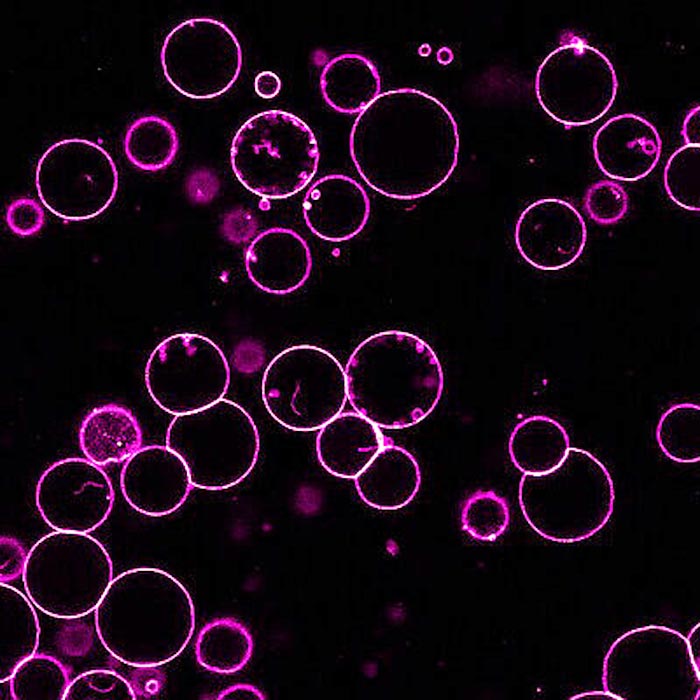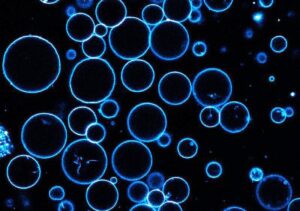Muscle health depends on lipid synthesis

Muscle membrane-derived Giant Plasma Membrane Vesicles (GPMVs) (Pink)
Domagoj Cikes
©Cikes/IMBA
Muscle degeneration, the most prevalent cause of frailty in hereditary diseases and aging, could be caused by a deficiency in one key enzyme in a lipid biosynthesis pathway. Researchers at the Institute of Molecular Biotechnology (IMBA) of the Austrian Academy of Sciences characterize how the enzyme PCYT2 affects muscle health in disease and aging in laboratory mouse models. The findings are published on March 20 in Nature Metabolism.
Muscle degeneration in inherited diseases and aging affects hundreds of millions of people worldwide. Degeneration of skeletal muscles, the body’s protein reservoir, leads to general physiological decline, a condition called frailty. Now, a research team led by Domagoj Cikes at IMBA and Josef Penninger at IMBA and the University of British Columbia (UBC) uncover the central role of an enzyme called PCYT2 in muscle health.
PCYT2 is known as the bottleneck enzyme in a major synthesis pathway of ethanolamine-derived phospholipids, the phosphatidylethanolamines (PEs). Based on patient data and using laboratory mouse and zebrafish models, they show that mutations affecting PCYT2, or its reduced activity, are conserved hallmarks of muscle degeneration across vertebrates. Specifically, they demonstrate that PCYT2 deficiency in muscles affects mitochondrial function and the physicochemical properties of the myofiber membrane.
Membrane rigidity, aging, and conservation in vertebrates

Domagoj Cikes
©Cikes/IMBA
Lipids are ubiquitously present in biological membranes and are present at particularly high concentrations in the membranes of nerve cells and neural tissues. Following reports that PE-based molecules enhance the membrane rigidity of liposomes, Domagoj Cikes, the study’s co-corresponding author and a former postdoctoral researcher in the Penninger lab at IMBA, hypothesized that this lipid species may play an important role in tissues subjected to constant shear stress, such as muscle tissue. “This assumption prompted me to selectively deplete PCYT2 in muscle tissues of animal models and study the outcome. In parallel, clinicians reported patient cases of mutations affecting PCYT2. The patients presented a condition called complex hereditary spastic paraplegia, a severe, multi-symptomatic disease characterized by leg muscle weakness, stiffness, and muscle wasting that worsened with time. However, given that the disease was just recently discovered, the underlying pathophysiological biology is vastly unknown,” says Cikes.
The researchers demonstrated that the levels of functional PCYT2 are linked to human muscle health and affect the muscle tissues of mice and zebrafish. The mouse models in particular showed striking and severe phenotypes of muscle growth retardation and quick deterioration upon PCYT2 depletion. They noted that this phenotype of fast deterioration in the mouse models resembled accelerated aging. Thus, Cikes and colleagues showed that PCYT2 plays a conserved role in vertebrates.
PEs are also abundant in mitochondrial membranes. Therefore, the researchers examined how PCYT2 depletion in muscle tissues affects mitochondrial membrane homeostasis and found that PCYT2 depletion indeed altered mitochondrial function and muscle energetics. However, a mitochondrial therapeutic approach was not sufficient to rescue the phenotype in mice. “This prompted us to think that there must be an additional mechanism driving the pathology,” says Cikes. Indeed, the team showed that the organization of the cell membrane lipid bilayer played an additional role. “This represents a novel pathophysiological mechanism that might also be present in other lipid-related disorders,” says Cikes.
In addition, the team demonstrated that PCYT2 activity decreased during aging in humans and mice. Using a targeted delivery technique of active PCYT2, the scientists were able to rescue muscle weakness in PCYT2-depleted mouse models and improve muscle strength in old mice.
Technical advances to understand the biology and pathophysiology
Having linked muscle health in vertebrates with PEs and muscle membrane composition, the researchers studied the role of lipid species in biological membranes. As biological work with lipids is particularly challenging, they also needed to think of ways to advance the available research applications. By adapting a technique developed by Kareem Elsayad at the Vienna BioCenter Core Facilities (VBCF) to measure tissue stiffness using Brillouin Light Scattering (BLS), the researchers were able to examine the physical properties of biological membranes. With this technique, the team demonstrated a considerable decrease in membrane surface stiffness when PCYT2 was depleted in mouse muscles. “In addition, our current work makes another leap forward in the field of lipid biology, as we were able to peek into the lipid bilayer of cell membranes and examine the local properties of structural lipids,” says Cikes. The technique is based on isolating Giant Plasma Membrane Vesicles (GPMVs) from biological tissues and studying the physicochemical properties and geometry of the membrane bilayer by means of an intercalating dye. This approach allows the scientists to examine how well the lipids in the bilayer are matched and whether they observe gaps, hydrophilic components, and leakages through the membrane.
The biology of lipids – crucial, yet understudied
“Current knowledge on the biology of lipids is largely over-simplified. The whole lipid field is summarized into a handful of molecular families, such as cholesterols, triglycerides, phospholipids, and fatty acids. It is a vast and unexplored molecular universe where the function of most species in health and disease is unknown.” says Cikes. By shedding light on the central effect of a lipid biosynthesis pathway in muscle health, Cikes and the team wish to highlight the importance and discovery potential of lipid research. “Our current work demonstrates a fundamental, specific, and conserved role of PCYT2-mediated lipid synthesis in vertebrate muscle health and allows us to explore novel therapeutic avenues to improve muscle health in rare diseases and aging,” concludes Penninger.
Josef Penninger was the founding director of IMBA and is currently the director of the Life Sciences Institute at the University of British Columbia (UBC), Vancouver, Canada.
Original publication:
Cikes, D., et al., “Critical role of PCYT2 in muscle health and aging”. Nature Metabolism, 2023. DOI: 10.1038/s42255-023-00766-2
About IMBA:
The Institute of Molecular Biotechnology (IMBA) of the Austrian Academy of Sciences (ÖAW) is one of Europe’s leading biomedical research institutes. IMBA is located at the Vienna BioCenter, Austria’s vibrant cluster of universities, research institutes, and biotech companies. IMBA research topics include chromosome biology, RNA biology, selfish elements and silencing mechanisms, functional genomics, cell and developmental biology, stem cell biology, molecular medicine, neuroscience, organoid research, and disease models.
Originalpublikation:
Cikes, D., et al., “Critical role of PCYT2 in muscle health and aging”. Nature Metabolism, 2023. DOI: 10.1038/s42255-023-00766-2
https://www.nature.com/articles/s42255-023-00766-2
Weitere Informationen:
Media Contact
All latest news from the category: Life Sciences and Chemistry
Articles and reports from the Life Sciences and chemistry area deal with applied and basic research into modern biology, chemistry and human medicine.
Valuable information can be found on a range of life sciences fields including bacteriology, biochemistry, bionics, bioinformatics, biophysics, biotechnology, genetics, geobotany, human biology, marine biology, microbiology, molecular biology, cellular biology, zoology, bioinorganic chemistry, microchemistry and environmental chemistry.
Newest articles

NASA: Mystery of life’s handedness deepens
The mystery of why life uses molecules with specific orientations has deepened with a NASA-funded discovery that RNA — a key molecule thought to have potentially held the instructions for…

What are the effects of historic lithium mining on water quality?
Study reveals low levels of common contaminants but high levels of other elements in waters associated with an abandoned lithium mine. Lithium ore and mining waste from a historic lithium…

Quantum-inspired design boosts efficiency of heat-to-electricity conversion
Rice engineers take unconventional route to improving thermophotovoltaic systems. Researchers at Rice University have found a new way to improve a key element of thermophotovoltaic (TPV) systems, which convert heat…



